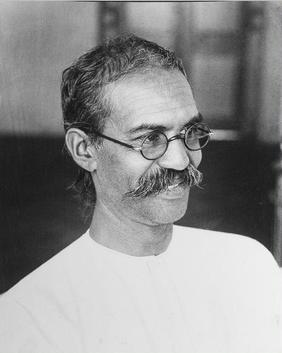Gijubhai Badheka facts for kids
Quick facts for kids
Girijashankar Bhagwanji Badheka
|
|
|---|---|

Gijubhai Badheka
|
|
| Born | 15 November 1885 Chittal, British India
|
| Died | 23 June 1939 (aged 53) Bhavnagar, Gujarat, India
|
| Known for | Education, Reforms, Children's Education, Dakshinamurti. Also known as Moochali Maa |
Gijubhai Badheka (born November 15, 1885 – died June 23, 1939) was an important Indian educator. He is famous for helping to bring the Montessori education method to India. People often called him "Moochhali Maa," which means "mother with whiskers." This nickname showed how much he cared for children.
Gijubhai started his career as a high court lawyer. However, after his son was born in 1913, he became very interested in how children grow and learn. This led him to change his path and focus on education. In 1920, Gijubhai founded the "Bal Mandir" pre-primary school. He also wrote many books about education, including a well-known one called Divaswapna ("Daydreams").
His Life Journey
Gijubhai Badheka was born in a place called Chittal in the Saurashtra area of western India. His first name was "Girijashankar." He grew up in Bhavnagar, a city in the western Indian state of Gujarat.
In 1907, Gijubhai moved to East Africa for work. Later, he moved to Bombay (now Mumbai) for his law studies. He became a lawyer in 1911. Gijubhai passed away on June 23, 1939, in Bhavnagar, India.
Here are some important moments in his life:
- 1885: Born on November 15 in Chittal.
- 1907: Traveled to East Africa.
- 1910: Began studying law in Bombay (Mumbai).
- 1913: His son, Narendra Bhai, was born. This event greatly influenced his interest in education.
- 1915: Became a legal advisor for Shri Dakshinamurti Bhavan, an educational institution.
- 1916: Gave up his law practice to work full-time in education at Dakshinamurti.
- 1920: Established the "Bal Mandir" school.
- 1925: Organized the first Montessori Conference in Bhavnagar.
- 1939: Died on June 23.
Making Education Better
Gijubhai's biggest contribution was to change how children were taught. In 1920, he started the Bal Mandir kindergarten. Later, he worked with other educators like Nanabhai Bhatt and Harbhai Trivedi to build the "Shree Dakshinamurti Gijubhai Vinay Mandir" school in Bhavnagar.
When Gijubhai was a young man, he went to college but couldn't finish his studies. In 1907, his family sent him to East Africa to find work. There, he met a lawyer named S. P. Stevens. Stevens taught Gijubhai the importance of being self-reliant, which means depending on yourself. This idea greatly impressed Gijubhai.
After returning to India in 1910, Gijubhai studied law in Bombay. He started his law practice in 1911. He got married twice. His first wife, Hiraben, passed away young. He then married Jariben in 1906.
In 1913, Gijubhai became a father. When he held his newborn son, he felt worried. He remembered his own childhood and how school often meant being punished. He wondered if there could be a better way to teach children, a way that wasn't scary.
Gijubhai believed that the real goal of education was for teachers to truly understand the children they were teaching. He felt that if children spent many hours with a teacher, they should also learn to love and respect that teacher. He saw that many schools at the time used fear to teach. Gijubhai thought that if children were treated with respect and given fun ways to learn, they would love coming to school. They would look forward to exploring the world with their teachers and friends.
To find these better ways, Gijubhai started reading and researching. This is how he discovered Maria Montessori and her ideas. Maria Montessori believed that children are born with amazing abilities to learn and grow. She felt that adults, or teachers, should act as guides to help children discover their own hidden talents. The child already has everything inside them; the adult just helps it unfold.
Gijubhai loved the Montessori method, which taught through "play-way" learning. Inspired by these ideas, he spent more time with teachers and schools. He decided he had to be the change himself. In 1915, he helped set up Dakshinamurti (Bala Bhavan) and a hostel in Bhavnagar. In 1916, he stopped being a lawyer and joined Dakshinamurti as an assistant superintendent.
Gijubhai created a system of child education that fit the Indian way of life. He trained teachers and wrote many books for children. He used ideas from Montessori and other educators, but he added his own mix of music, dance, travel, storytelling, and outdoor play. The main ideas behind his schools were freedom and love. His schools became very popular. Even Mahatma Gandhi admired Gijubhai Badheka and called him "Moochhali Maa" (mother with whiskers), a name that stuck with him.
Books He Wrote
Gijubhai Badheka wrote nearly 200 books, including many storybooks. He wrote about children, education, travel, and humor. His main focus was creating books for children, parents, and teachers.
Here are some of his notable works:
| Title | Year | Notes |
|---|---|---|
| Rakhdu Todi | 1929 | Gujarati Translation of Free School OR A Dominie's Five |
| Divaswapna - An Educator’s Reverie | 1939 | A famous book about his educational ideas. |
| Montessori Padhati | 1927 | About the Montessori Method. |
| Varta | 1929 | A periodical with over 100 stories. |

